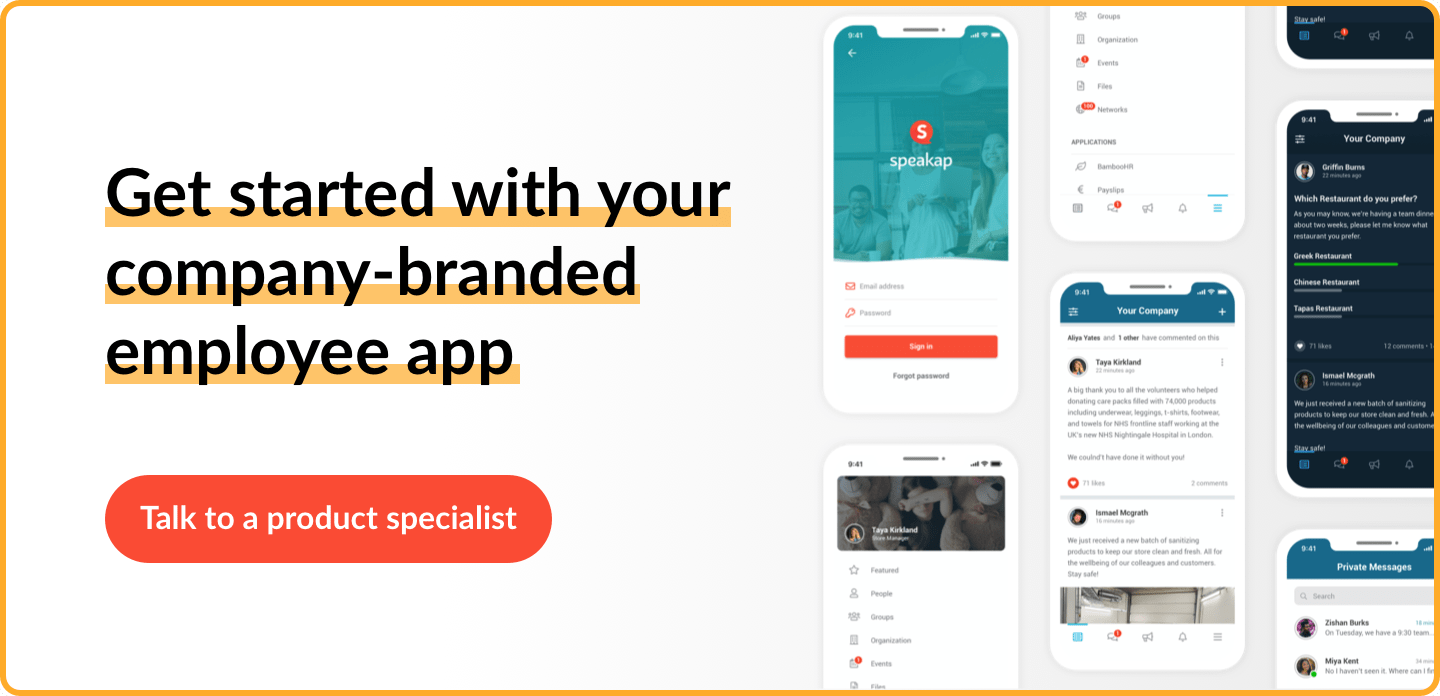Why Frontline Workers Need a Single Source of Truth
If today’s labor market suggests anything, it’s that companies need to rethink their retention and recruitment strategies.
The hospitality industry, for instance, has seen the average hourly wage go up 22% since November 2019, according to the Bureau of Labor Statistics. This has changed since the pre-pandemic as employers offer more competitive pay to refill positions lost or eliminated during Covid. While most sectors are still hiring, hospitality firms in particular have responded with higher wage growth than any other sector.

However, while wage growth has had a positive impact on workers’ lives and helped shore up gaps in the labor force, wage increases have diminishing returns for organizations. You can’t simply throw more money at the problem and expect better results. The question for employers is: how can you create smaller investments with a greater impact on your workforce? One solution is to create better experiences for frontline workers. A positive workplace culture that promotes community, inclusivity, and transparency can motivate employees and deliver up to 72% higher employee engagement rates.
What eventualities can you prepare for to ensure that your workforce is well-informed, well connected, and has access to the tools and information they need to be successful and stay engaged? And if they’re seasonal frontline workers, how do you prepare for them to come back?
Make Information Accessible for Frontline Workers
Companies need to commit to employee communication initiatives, and need to constantly nurture employee engagement.
It’s key to have one channel, one line of communication, one source of truth. The risk of having multiple communication channels on which to reach frontline workers is costly and can affect the impact you strive to create. For instance, organizations that use digital signage screens find that it’s difficult to track data. That also creates little overview as to whether employees are receiving important information.
With multiple communication channels, the effectiveness of internal communications is easily diluted. That’s why focusing on one channel, like an employee app, is key. That being said, you can always use other tools as support, such as digital signage screens to redirect employees to the app. A digital signage screen could for instance contain a QR code leading your frontline workers to your app for bite-sized – yet crucial – company information.

Turning Frontline Workers Into Information-Seekers
The three buckets of communication consist of: what you want to know, what you need to know, and what others want you to know. How do you pull frontline workers into an employee app when they’re not necessarily seeking out information?
Let’s look at communication in three parts:
What frontline workers want to know: This is information that they’re seeking on their own and are linked to their interests. For instance, maybe they’d like to know what kind of food truck will be at the job site next week.
What frontline workers need to know: This is information that’s important to them and that they will actively seek out on their own. For instance, they would need to know about access to their pay stubs, new training, and work schedule.
What you want frontline workers to know: This information is generally top-down and is more difficult to amplify as fewer people will go looking for it. Examples of this include the company needing the employees to know about new procedures, important updates, or winning an important contract.
Once you’ve made that distinction, your strategy should include drawing in employees with the information they’re already seeking out and simultaneously exposing them to the information you want them to read. That’s why an employee app – the single source of truth – works so well. Once frontline workers start to read the information you need them to read, they see the impact that it has on their job. You’re then able to achieve a cycle of active engagement using company communications.
And it doesn’t stop there. Similarly to personal social media, you’re able to tailor the way that your frontline workers consume both the information they want, and the information you need to communicate. With an employee app, tracking that engagement and predicting with a high degree of accuracy the type of content is landing and what still needs adjusting, is made possible.

A thoughtful internal communicator can, therefore, tailor content and experiences according to the departments that frontline workers belong to, the groups they’re affiliated with, and draw them in, as opposed to constantly pushing content. This strategy is bound to bring in bigger results. And although higher wages have incentivized employees, it’s time to focus on intrinsic motivation, which can have a lasting impact through better communication and engagement. When frontline workers are well-informed about their company and have a connection to it and their colleagues, it has an effect on productivity that can lead to business growth.
Why Frontline Workers Need a Single Source of Truth

If today’s labor market suggests anything, it’s that companies need to rethink their retention and recruitment strategies.
The hospitality industry, for instance, has seen the average hourly wage go up 22% since November 2019, according to the Bureau of Labor Statistics. This has changed since the pre-pandemic as employers offer more competitive pay to refill positions lost or eliminated during Covid. While most sectors are still hiring, hospitality firms in particular have responded with higher wage growth than any other sector.

However, while wage growth has had a positive impact on workers’ lives and helped shore up gaps in the labor force, wage increases have diminishing returns for organizations. You can’t simply throw more money at the problem and expect better results. The question for employers is: how can you create smaller investments with a greater impact on your workforce? One solution is to create better experiences for frontline workers. A positive workplace culture that promotes community, inclusivity, and transparency can motivate employees and deliver up to 72% higher employee engagement rates.
What eventualities can you prepare for to ensure that your workforce is well-informed, well connected, and has access to the tools and information they need to be successful and stay engaged? And if they’re seasonal frontline workers, how do you prepare for them to come back?
Make Information Accessible for Frontline Workers
Companies need to commit to employee communication initiatives, and need to constantly nurture employee engagement.
It’s key to have one channel, one line of communication, one source of truth. The risk of having multiple communication channels on which to reach frontline workers is costly and can affect the impact you strive to create. For instance, organizations that use digital signage screens find that it’s difficult to track data. That also creates little overview as to whether employees are receiving important information.
With multiple communication channels, the effectiveness of internal communications is easily diluted. That’s why focusing on one channel, like an employee app, is key. That being said, you can always use other tools as support, such as digital signage screens to redirect employees to the app. A digital signage screen could for instance contain a QR code leading your frontline workers to your app for bite-sized – yet crucial – company information.

Turning Frontline Workers Into Information-Seekers
The three buckets of communication consist of: what you want to know, what you need to know, and what others want you to know. How do you pull frontline workers into an employee app when they’re not necessarily seeking out information?
Let’s look at communication in three parts:
What frontline workers want to know: This is information that they’re seeking on their own and are linked to their interests. For instance, maybe they’d like to know what kind of food truck will be at the job site next week.
What frontline workers need to know: This is information that’s important to them and that they will actively seek out on their own. For instance, they would need to know about access to their pay stubs, new training, and work schedule.
What you want frontline workers to know: This information is generally top-down and is more difficult to amplify as fewer people will go looking for it. Examples of this include the company needing the employees to know about new procedures, important updates, or winning an important contract.
Once you’ve made that distinction, your strategy should include drawing in employees with the information they’re already seeking out and simultaneously exposing them to the information you want them to read. That’s why an employee app – the single source of truth – works so well. Once frontline workers start to read the information you need them to read, they see the impact that it has on their job. You’re then able to achieve a cycle of active engagement using company communications.
And it doesn’t stop there. Similarly to personal social media, you’re able to tailor the way that your frontline workers consume both the information they want, and the information you need to communicate. With an employee app, tracking that engagement and predicting with a high degree of accuracy the type of content is landing and what still needs adjusting, is made possible.

A thoughtful internal communicator can, therefore, tailor content and experiences according to the departments that frontline workers belong to, the groups they’re affiliated with, and draw them in, as opposed to constantly pushing content. This strategy is bound to bring in bigger results. And although higher wages have incentivized employees, it’s time to focus on intrinsic motivation, which can have a lasting impact through better communication and engagement. When frontline workers are well-informed about their company and have a connection to it and their colleagues, it has an effect on productivity that can lead to business growth.
Stay updated with the latest insights and trends delivered straight to your inbox.











